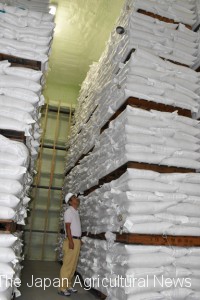TOKYO, Sept. 17 – “Even if the domestic agricultural market is liberalized, the nation can survive with strong agriculture.” “Japan liberalized its rice market 25 years ago, but that did not affect domestic supply and demand.” – These are the excuses the government gives as it creates new free trade agreements one after another.
However, the actual impact of rice market liberalization has been deep and long-standing. In fiscal 2015, 50.5 billion yen of tax money, a record high amount, was used to cover the loss on sales of so-called “minimum access” rice, rice imported under an annual tariff-free quota. Forcible market liberalization is putting pressure on agricultural budgets and continues to impose a burden on farmers and taxpayers.
The temperature at a warehouse for minimum access rice in the city of Chiba is strictly maintained at 13 degrees centigrade. Rice imported from Thailand, packed in 30-kg bags, are neatly stacked 36 high, waiting to be shipped.
“Minimum access rice is stored carefully, in the same way as for domestic rice,” says a warehouse firm official. But most of minimum access rice is shipped to be used as livestock feed, which does not require strict quality control like rice for human consumption.
Profits and losses regarding minimum access rice are managed under the agriculture ministry’s special account. The account, calculated by deducting sales proceeds from the sum of purchase and management expenses, incurred a deficit of 50.5 billion yen in fiscal 2015, the latest available data. Funds from the general account are transferred to make up for the loss, thus squeezing the agriculture-related budget.
“The deficit ballooned that year because prices of domestically-grown rice dropped, leading to a decline in sales of imported rice consumed as staple food which do not go into the red,” a farm ministry official explained. The deficit is expected to shrink in fiscal 2016, but the deficit-causing mechanism of minimum access rice, in which rice purchased at high price is sold at low price, will remain along with storage costs.
According to the agriculture ministry’s calculation, if minimum rice which costs 70,000 yen per ton is sold at 30,000 yen to be used as animal feed, there will be a loss of 40,000 yen. The deficit is pushed up in recent years, as most of imported rice is sold as feed. Since the minimum access rice import system began in 1995, a total of 15 million tons have been imported to Japan. The total amount of tax money used in the last 20 years to cover the losses involving minimum access rice reached 364 billion yen.
The ministry says the coverage of the losses “cannot be helped.” This is because when Japan internationally pledged in the end of 1993 it will import rice, the government domestically declared it will not force rice farmers to change crops along with the start of rice imports. If minimum access rice totaling 767,000 tons before milling are put on the market every year without control, it would have a grave impact on domestic production. The government should inevitably cover the loss incurred by purchasing minimum access rice and selling it for feed or other uses to keep the domestic rice supply and demand in balance.
However, two concerns remain. While minimum access rice is becoming a heavy burden on the state budget, the government plans to further boost imports. Although the administration of U.S. President Donald Trump has made the prospects of the Trans-Pacific Partnership agreement uncertain, Japan has agreed under the deal to increase the import quota for rice made in the U.S. and Australia. The government should not make light of the already heavy burden brought about by rice imports.
Another concern is that high-priced U.S. rice occupies nearly half of minimum access rice. The agriculture ministry has apparently been manipulating deals to give the U.S. an advantage ever since the system started. The purchase price of U.S. rice in fiscal 2015 was nearly double the price of Thai-made long grain rice. This is also contributing to expanding deficits.
“Based on the objectives of the system, we conduct purchase bidding basically for rice for human consumption, and that is why we end up buying more U.S. rice which is similar to domestically-grown rice,” says an agriculture ministry official.
Kyushu University Prof. Shoichi Ito said: “The government can reduce the deficits if the ministry purchases minimum access rice from countries that offer lower prices. The ministry’s move goes against taxpayers’ interests.”


